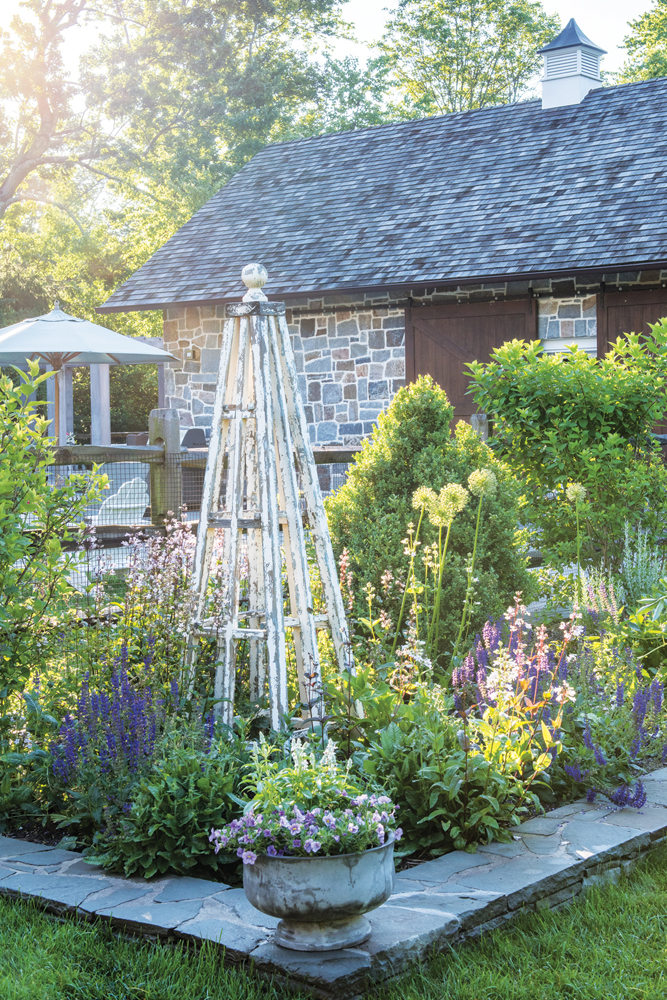En Garde
Writer Mary Vinnedge | Photographer Patricia Burke | Location Essex Fells, NJ | Landscape Design Susan Cohan, APLDA landscape designer attacks a cluster of problems in Essex Fells.
When it comes to challenges, landscape designer Susan Cohan is no shrinking violet. In planning a two-acre garden in Essex Fells located in New Jersey, she faced off against voracious deer, digging Labrador retrievers, a steep slope, poor drainage and compacted clay soil. But Cohan, a member of the Association of Professional Landscape Designers, points to one trump factor working in her favor: clients who are patient, understanding and in sync with her vision.
The collaboration began in 2011, when the landscape was nearly all lawn, says the wife, who had admired photos of Cohan’s work on Facebook. “It was a perfect match” from their first meeting, the wife says. Although the homeowners had already contracted to do the pool and pool house (built in 2012), Cohan joined the team before construction, which allowed her to head off problems. For instance, she moved the spa to improve entertaining flow on the patio.
“The goal for me was to tie together the pool, house and pool house,” says the landscape designer, whose firm is Susan Cohan Gardens in Chatham, NJ. Key unifying elements are a cool palette for blossoms and stonework in the garden that complements stone on the structures without matching.
But first things first: drainage. “We pulled out trees that were sitting in water although the soil on top was dry,” Cohan says. “The backyard was a swamp that got overflow from the road and runoff from the hill. A large [underground] drainage system now mitigates that.”
……
When designing, Cohan took cues from photos her client had pulled from magazines and Pinterest. “I wanted it to appear very natural,” the wife says. “I was very particular about it. I didn’t want too many colors—that’s not pleasing to the eye. I wanted blues, purples and a little bit of pink and white.”
The few existing planting beds were incorporated into the design, Cohan says, “so we just massaged them.” Workers filled holes and built walls for raised beds, adding “mountains of compost and soil as well as gypsum to break up the heavy clay” to keep plants happy without constant pampering.
Plants also must coexist with deer. As Cohan puts it, “You won’t have roses, but you can have blossoms and color and scent.” The property’s only fence is around the pool, Cohan says, so everything beyond needs to be deer-resistant. The exception is the hydrangeas, and “right now the deer are leaving them alone.” The wife says the deer forced her only compromise in the project. “I couldn’t have some plants I wanted, like hosta.”
The family’s Labrador retrievers figured heavily into the project too. “My dogs come before everything else with the garden,” the wife says. “They don’t dig up plants so much as they go after chipmunks.” The solution: Temporary fencing allows plants to become established without canine interference. After that, care is minimal, Cohan says: Early each year, there’s weeding and mulching, and after that “it’s not huge maintenance, just weeding and deadheading.”
……
Although Cohan designed the entire acreage right away, implementation was phased at the homeowners’ request. “I’m really busy,” says the wife, who does most of the container plantings. “I have three sons and my dogs. I didn’t want to make too many decisions at once. We like to do research and do things right. I waited to do the hill because I wanted to live with it awhile.”
Its time came in 2015. The “mass of pachysandra and weeds,” as Cohan describes the hill, was tamed with reclaimed granite curbs used as steps in the turf grass plus a two-tiered area of blooming plants and ornamental grasses designed to be viewed from the pool. Cohan terraced the planting with boulders, some that were already on-site and others brought in to match.
The entire garden is designed for a sequence of blooms, starting with bulbs and redbud trees. “The peak bloom is up to the Fourth of July,” Cohan says. “Then it’s grasses and a couple of showier things. The color [including asters] ramps up again in fall” when family members return from their shore home.
All the while, “my plan is for plants to duke it out with each other, and the strongest survive,” Cohan says. If a plant struggles in a particular spot, she moves in something that’s doing well elsewhere.
The homeowners are on board with that philosophy. “Often when you plant a garden you have to realize that in a year or two, everything grows and changes,” the wife says. “It’s not instant gratification. Sometimes there’s something that should work but the deer or dogs get into it. I learned patience from our three sons…We’re not perfectionists. Things can be beautiful and not be perfect.”
“Every year we do a little bit more,” Cohan adds. “I never wanted the property to look like it was just done. We wanted it to look like it was done over time.
“And now it has been done over time, over about five years,” she says with a laugh.
Freelance writer Mary Vinnedge, an avid gardener, is a big fan of Susan Cohan’s sense of humor and practical approach to landscape design.








